
The Effect of Stereo Display Deficiencies on Virtual Hand Pointing Inproceedings
Mayra D. Barrera Machuca, Wolfgang Stuerzlinger
Abstract:
The limitations of stereo display systems affect depth perception, e.g., due to the vergence-accommodation conflict or diplopia. We performed three studies to understand how stereo display deficiencies impact 3D pointing for targets in front of a screen and close to the user, i.e., in peripersonal space. Our first two experiments compare movements with and without a change in visual depth for virtual respectively physical targets. Results indicate that selecting targets along the depth axis is slower and has less throughput for virtual targets, while physical pointing demonstrates the opposite result. We then propose a new 3D extension for Fitts' law that models the effect of stereo display deficiencies. Next, our third experiment verifies the model and measures more broadly how the change in visual depth between targets affects pointing performance in peripersonal space and confirms significant effects on time and throughput. Finally, we discuss implications for 3D user interface design.
